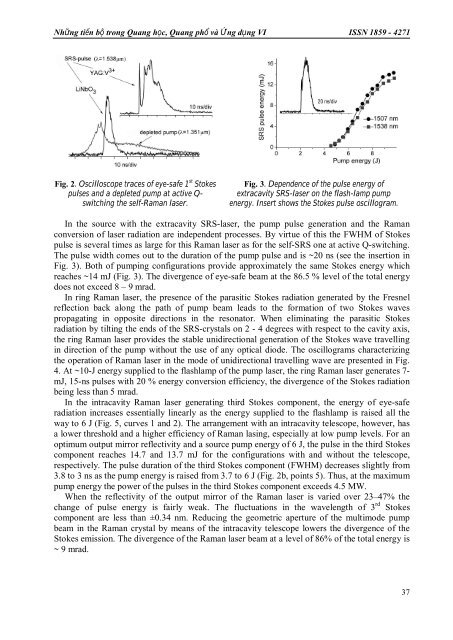Nhng tin b trong Quang hc, Quang ph và ng dng VI ISSN 1859 - 4271
Nhng tin b trong Quang hc, Quang ph và ng dng VI ISSN 1859 - 4271
Nhng tin b trong Quang hc, Quang ph và ng dng VI ISSN 1859 - 4271
You also want an ePaper? Increase the reach of your titles
YUMPU automatically turns print PDFs into web optimized ePapers that Google loves.
Nhữ<strong>ng</strong> tiến bộ <stro<strong>ng</strong>>tro<strong>ng</strong></stro<strong>ng</strong>> <stro<strong>ng</strong>>Qua<strong>ng</strong></stro<strong>ng</strong>> học, <stro<strong>ng</strong>>Qua<strong>ng</strong></stro<strong>ng</strong>> <stro<strong>ng</strong>>ph</stro<strong>ng</strong>>ổ và Ứ<strong>ng</strong> dụ<strong>ng</strong> <strong>VI</strong> <strong>ISSN</strong> <strong>1859</strong> - <strong>4271</strong>Fig. 2. Oscilloscope traces of eye-safe 1 st Stokespulses and a depleted pump at active Q-switchi<strong>ng</strong> the self-Raman laser.Fig. 3. Dependence of the pulse energy ofextracavity SRS-laser on the flash-lamp pumpenergy. Insert shows the Stokes pulse oscillogram.In the source with the extracavity SRS-laser, the pump pulse generation and the Ramanconversion of laser radiation are independent processes. By virtue of this the FWHM of Stokespulse is several times as large for this Raman laser as for the self-SRS one at active Q-switchi<strong>ng</strong>.The pulse width comes out to the duration of the pump pulse and is ~20 ns (see the insertion inFig. 3). Both of pumpi<strong>ng</strong> configurations provide approximately the same Stokes energy whichreaches ~14 mJ (Fig. 3). The divergence of eye-safe beam at the 86.5 % level of the total energydoes not exceed 8 – 9 mrad.In ri<strong>ng</strong> Raman laser, the presence of the parasitic Stokes radiation generated by the Fresnelreflection back alo<strong>ng</strong> the path of pump beam leads to the formation of two Stokes wavespropaga<s<stro<strong>ng</strong>>tro<strong>ng</strong></stro<strong>ng</strong>>>tin</s<stro<strong>ng</strong>>tro<strong>ng</strong></stro<strong>ng</strong>>>g in opposite directions in the resonator. When elimina<s<stro<strong>ng</strong>>tro<strong>ng</strong></stro<strong>ng</strong>>>tin</s<stro<strong>ng</strong>>tro<strong>ng</strong></stro<strong>ng</strong>>>g the parasitic Stokesradiation by til<s<stro<strong>ng</strong>>tro<strong>ng</strong></stro<strong>ng</strong>>>tin</s<stro<strong>ng</strong>>tro<strong>ng</strong></stro<strong>ng</strong>>>g the ends of the SRS-crystals on 2 - 4 degrees with respect to the cavity axis,the ri<strong>ng</strong> Raman laser provides the stable unidirectional generation of the Stokes wave travelli<strong>ng</strong>in direction of the pump without the use of any optical diode. The oscillograms characterizi<strong>ng</strong>the operation of Raman laser in the mode of unidirectional travelli<strong>ng</strong> wave are presented in Fig.4. At ~10-J energy supplied to the flashlamp of the pump laser, the ri<strong>ng</strong> Raman laser generates 7-mJ, 15-ns pulses with 20 % energy conversion efficiency, the divergence of the Stokes radiationbei<strong>ng</strong> less than 5 mrad.In the intracavity Raman laser genera<s<stro<strong>ng</strong>>tro<strong>ng</strong></stro<strong>ng</strong>>>tin</s<stro<strong>ng</strong>>tro<strong>ng</strong></stro<strong>ng</strong>>>g third Stokes component, the energy of eye-saferadiation increases essentially linearly as the energy supplied to the flashlamp is raised all theway to 6 J (Fig. 5, curves 1 and 2). The arra<strong>ng</strong>ement with an intracavity telescope, however, hasa lower threshold and a higher efficiency of Raman lasi<strong>ng</strong>, especially at low pump levels. For anoptimum output mirror reflectivity and a source pump energy of 6 J, the pulse in the third Stokescomponent reaches 14.7 and 13.7 mJ for the configurations with and without the telescope,respectively. The pulse duration of the third Stokes component (FWHM) decreases slightly from3.8 to 3 ns as the pump energy is raised from 3.7 to 6 J (Fig. 2b, points 5). Thus, at the maximumpump energy the power of the pulses in the third Stokes component exceeds 4.5 MW.When the reflectivity of the output mirror of the Raman laser is varied over 23–47% thecha<strong>ng</strong>e of pulse energy is fairly weak. The fluctuations in the wavele<strong>ng</strong>th of 3 rd Stokescomponent are less than ±0.34 nm. Reduci<strong>ng</strong> the geometric aperture of the multimode pumpbeam in the Raman crystal by means of the intracavity telescope lowers the divergence of theStokes emission. The divergence of the Raman laser beam at a level of 86% of the total energy is~ 9 mrad.37















